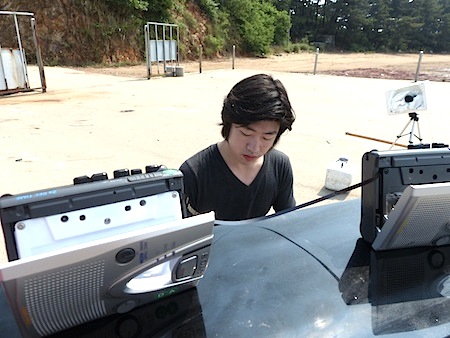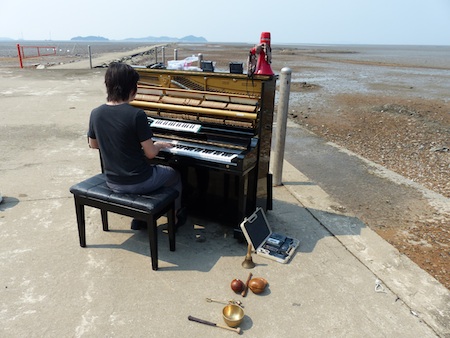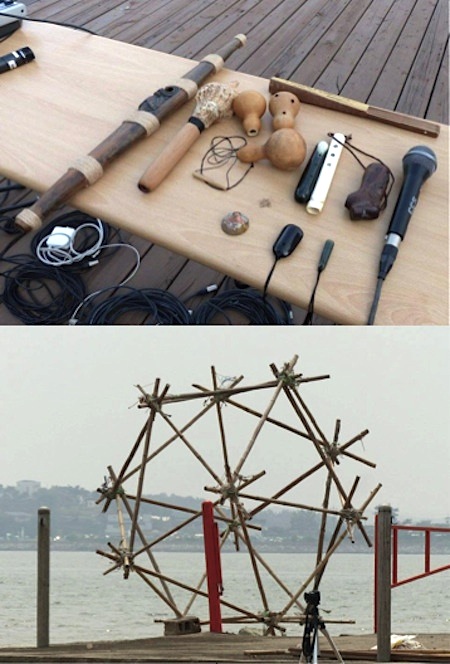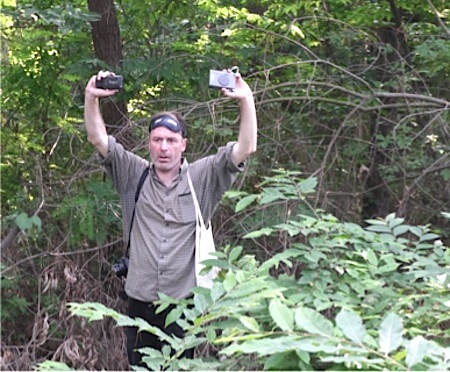
This SoundBlog guest contribution by Ian-John Hutchinson is an article written not long after the 18th unPublic, which - one year ago, on June 14th 2015 - had him perform on the beach of the South-Korean island of Daebu, together with Taewon Lee, Samir Abdelhamid and Emmanuel Rébus. Afterwards Ian-John interviewed all of that unPublic's participants, and wrote things down, thus providing some interesting insights into the processes and intentions at play during this episode, and the unPublic series in general.
unPublic #18 - 대부도 (Daebu-Do), 14 June 2015
by Ian-John Hutchinson
june 14, 2016.
The only difference with a concert is, these are not concerts
Harold Schellinx
(unPublic series founder and curator)
--
Centuries of centuries and only in the present do things happen
Jorge Luis Borges
What can we ascertain by listening to this recording? That the location is outdoor and suffers frequent aircraft over-flights. That bird-life is sparse. It could be inferred that detritus was laying about. Mangy pieces of polystyrene, ropes, poles, lengths of bamboo, netting. Shells, stones are also heard to be there. That it is a spacious, uninhibited area could be guessed at from the way that sound sources move from the foreground into the distance, and from the depth from which some sounds reach the microphones. There is nothing in the recording to indicate the presence of a coastal military installation on the low cliff directly behind where the piano stood. Neither would it be necessarily obvious that this is the foreshore, and that the sea visits here.
Emmanuel Rébus: "I first visited the Gyeonggi Creation Center (GCC) in Daebu-do in 2012 to give a talk about mathematics and sound art. At that time the buildings were not as well equipped and refurbished as they are now and GCC was really looking like an abandoned high school haunted by a few artists. I highly appreciated the unique atmosphere of the place. Also the island of Daebu-do in itself has a special appeal to me. Its location in the vicinity of the industrial and multicultural city of Ansan, the fact that grapes are grown there, that a strange form of wine is experimented there, the typical K-Kitsch tourist pensions mixed with the old fishermen culture ... Daebu-do is probably not the most beautiful island in Korea, but certainly has a unique soul..."
Lee Taewon (이태원): "Festival organizer Lee Daeil (이대일) saw me playing melodica and keyboard in an aggressive way in Bulgasari in Yogiga early this year, I think he might have thought and found my works are based on the instinct from subconscious, mainly showing raw emotion, which can be related to (the festival theme of) ‘prehistory: sound : movement’. I am not sure if my works are that raw, but as a musician who does improvisation pieces a lot, I cannot deny if someone says that my music is rough.
...in my case, going to Daebu-do was definitely a good chance to make use of the nature surroundings like the forest, mud flat, bird chirping, and the tidal rythms around the sea side, which were totally new experience for me to find the link between the sound that I make and the outdoor resonance."
 |
 |
| Lee Taewon and piano at the foreshore |
ian-john: "I was thinking about several participation works that would take advantage of different features of the island. Specifically the bush, where the trees provide some acoustic reflection and the thick foliage restricts vision and movement, in contrast to the gently sloping valley which is horizontally wide open...and also has a vertical dimension because of the tall buildings at GCC. And then also the tidal foreshore that is entirely horizontal and exposed ...exposed to the sky, and to the many sounds carrying across the wide bay from distant parts of the island. I was interested in what sonic exploration activities these environments would suggest to the artists and other festival participants."
Samir Abdelhamid: "I mainly played Taonga puoro. Two Koauau (short maori flutes made from bone and pounamu), Nguru (a traditional short flute shaped like a whale's tooth), Koauau ponga ihu (a small gourd nose flute), Putatara (traditional shell trumpet), Karanga manu (a bird call), Karanga weka (a bird call specifically designed to call weka), Putorino (a traditional flute/bugle) Poi awhiowhio (a spun instrument used to lure birds). I mainly played Taonga puoro... but I also played a singing bowl, which is a bit unusual as I normally play nothing but Taonga puoro for both recordings and live performances."
Emmanuel: "In the preceding days I had developed there a conceptual project based solely on objects found on the shores of Daebu-do. I accumulated many bamboo rods, pieces of ropes, styrofoam or plastic buoys. In addition to that, I came with a micro-cassette dictaphone, containing some private recordings in Korean (found in a flea market in Seoul). I also used a cheap recording device and a camera, as the recording process in itself is part of the project."
Taewon: "First of all, our performance site was located around the wharf that is connected to the long path to the sea all the way through the mud flat and I put a black upright piano around the entrance of that sea trail. The ground was covered with the cement roughly and there were some abandoned fishing tools scattered around.
As the Sunday morning session on 14th had not been scheduled before I went to the festival, my initial idea was only focused on playing piano and capturing the moment on my video camera, when I play piano with some kind of other sound objects that I brought, such as the buddhist wood block (목탁), Korean Shaman handbell (요령), brazen vessel and a red megaphone. Even though, to be honest, I didn’t intend, it is really interesting that all those instruments had a function to serve many rituals in Korean culture, whether it was for Buddhism, traditional shamanism or whatever. Even the red megaphone could be commonly found in Korean conventional markets, when the sellers try to attract the customers into their limited time sale (is it too much if I say that is another type of ritual?)"
 |
| Top: Taonga Puoro instruments used by Samir Abdelhamid. Below: Polyhedron made of foreshore detritus and demonstrating basic mathematical relationships also pertaining to music, by Emmanuel Rébus. |
ij: "...what I was carrying on me that day were tape cassette walkmans...Sony or Panasonic ones with their own microphones and little built in mono speakers...and several kinds of tapes, loop tapes that I’d made myself and also a simple system where the tape from one cassette is spliced to the tape from another so that they can be used to make a simple tape echo system...I am interested in how Emmanuel, Harold and other artists are re-purposing recording/playback devices into performance tools and instruments...,...and I took 2 small Sony PCM M10 sound recorders...but I only have one wind muff, so I placed the other one into the back of the piano to be out of the wind."
“I have an idea that democracy among living people requires democracy among the dead. In other words, it requires an openness to the past, a sense of puzzlement about the past, a sense that the past is difficult to understand and that the past has many different voices and viewpoints,” Keane said in an interview with The Korea Herald. The professor also took issue with the government’s crackdown on those who protested on Nov. 14 against labor reforms and state textbooks. Keane said that such dissatisfaction with the government and street protests are “normal” phenomenon in contemporary democracies. (2015.11.29)
Samir: "That morning, I drove down to the dock 3, and found Ian-John, Taewon and Emmanuel there. They were improvising pieces and asked me to join them. The piano was set up along with many "found" instruments. The sun had risen and the tide was out. I heard the waves crash, birds call out and the melody of the ocean beckon me to create out of the beautiful scenery. We spent about 3 hours or so improvising and playing at the dock."
Emmanuel: "Nothing was prepared in advance, it was a complete improvisation. A special mood, to my ears different than just the addition of the contributions of individuals, emerged after a while from this unique combination of performers who were not really used to play together, and who were coming from slightly different cultures and backgrounds."
Taewon: "Ian-John and Emmanuel found many of that white snowball-like-looking fishing tools and tried to rub it onto anywhere, even onto the piano. It sounded like DJ moving his finger fast to make scratch. Also, Ian-John threw that light white buoy onto the piano while I was playing it as if we were having a snowball fight. Meanwhile his cassette tapes put on the lid part of the piano were making some bird noise. Emmanuel played his cassette tape too and it seemed like he was playing his new recordings made in the last two days in the festival, including my shouting voice to mimic the hen’s cackling in the cage around GCC on the first day in Daebu-do. Samir added his very own maori style sound to this whole atmosphere coming in and out of the video angle. When I stopped playing piano from time to time during the session, I wandered around just like others."
 |
| Emmanuel Rébus at another location on Daebu-do |
Samir: "The water world is my element. I was listening for the voice of Tangaroa as usual."
ij: "...the megaphone could make a very low volume feedback that would appear and disappear depending on sounds that others were making...I walked away from the piano out onto the mud flats, listening to the sounds grow distant until I was maybe 300 meters away...then I found 2 polymer buoys and I tied them to my ankles and dragged them along with me...sounds were echoing off the low cliff face beyond the shore..."
Taewon: "GCC is now currently located in Seongam Village, where Seongam School used to be until 1982. That school...was built in 1942 around the late Japanese colonial era in Korea to detain young juveniles found delinquent, judged by the Japanese police under the dubious criteria. The detained youngsters were severely trained, even up to death, to change their mind to be faithful soldiers, who can sacrifice their life to the Japanese imperialism. Even worse and more horrible fact is that this school still lasted after Korea was liberated from Japan. Around the dictatorial era, this school served a function to maintain the so-called social order with the same policy that Japanese police had had."
Emmanuel: "In particular, no audience is invited for the unPublic series of "performed recordings". This reflects the fact that we live in a world where "music" is omnipresent, where the notions of "recording" and of "concert" have been dissolved in the digital culture, and it does not really make sense to pretend that we are still at the times of Ravel or Debussy or even Stockhausen. I interpret the concept of "unPublic" as a reflection on such facts that a musician of nowadays cannot ignore."
Interviews conducted by ian-john (Chuncheon, South Korea). Some contributors are not native English speakers, and where their meaning seems clear I have not made corrections.
The following short uToop sequence was extracted from videos shot by Taewon Lee during the unPublic at Daebu-do:
Read about unPublic on the SoundBlog:
(2023, november 3-..) - Ethereal Reverberations. A Decade of unPublic (« Dix ans qu'on fait la musique sans public ») (uP#100)
(2023, august 20) - Three days of residency at Les Ateliers Claus, Brussels (uP#65, uP#93, up #94)
(2022, september 2) - Three Musketeers Musicking Maastricht & La Générale (uP#86, up #87)
(2022, august 4) - Berlin: Zero Cohesion (3) (uP#84)
(2022, july 24) - Berlin: Zero Cohesion (2) (uP#83)
(2022, july 11) - Berlin: Zero Cohesion (1) (uP#82)
(2022, july 2) - X-unPub (uP#81)
(2022, march 13) - "Manifeste" (uP#80)
(2021, june 13) - Die Stillgestandenen (The Stillstands / Standstills / Stillstanders) (uP#67)
(2021, may 02) - Playing Apart Together: Chuncheon↯Paris (uP#73)
(2018, november 02) - "Five years stuck on my eyes" (Lustrum Non Publicum) (uP#56)
(2018, september 01) - t'Obsolete or not t'Obsolete ... [iv] (uP#54)
(2018, august 13) - Rage, rafts & refugees (uP#49, uP#50)
(2018, august 10) - t'Obsolete or not t'Obsolete ... [iii] (uP#45)
(2017, june 11) - Moving out, of, on ... [ii] (uP#42)
(2016, june 10) - unPublic #18 - 대부도 (Daebu-Do), 14 June 2015 (uP#18)
(2016, may 07) - In Praise of Slowness (uP#21)
(2015, july 15) - Bridges, troubles, water (uP#19)
(2015, april 14) - Mal-là--colisé dans l'espace et dans le temps (uP#16)
(2014, august 02) - Appearance and Reality (uP#8)
(2014, march 08) - "12 - 11 - 9 - 10 - 3 - 6 - 7 - 1 - 2 - 8 - 4 - 5" (uP#5)
(2013, december 31) - Candles, Cassettes & Champagne (uP#4)
(2013, november 23) - unPublic 1, 2 (sauf riverains) (uP#1, uP#2)
Read about unPublic on Medium:
April 16, 2022 - Playing Apart Together (uP#66-#69)
March 17, 2022 - All delusion is expansive (uP#80)
November 10, 2021 - The Future always was Yesterday
Read about unPublic in Gonzo (Circus) [Dutch]:
Gonzo #143, januari/februari 2018 - Met kop noch staart: muzhakdag! (uP#48)
Gonzo #139, mei/juni 2017 - De waan, de wil, de weg
Read about unPublic elsewhere:
Plus-X-Creative, january 2022 - Playing Apart Together
Electronic Cottage, november 2018 - unPublic - 'Five Years stuck on my eyes' -sketch as a memoire
To listen, download & support, visit unPublic @ Bandcamp.
tags: unPublic, Daebu-do, South-Korea
# g.002.
comments for unPublic #18 ::
|
Comments are disabled |